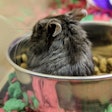A basic element of a petfood safety program is a plant schematic that depicts the flow of people and products. Process and product flows are important considerations in the development, implementation and maintenance of a plant's HACCP (hazard analysis critical control points) program. Understanding employee and product flow helps identify potential product contamination points and then develop the means to prevent that contamination from occurring.
Food products, including petfoods, typically undergo a process to reduce the presence of pathogens. This process may involve cooking (hence the term cook side vs. raw side), pasteurization, washing and so forth. It is imperative that finished product be protected from cross-contamination (e.g., situations where allergen ingredients, additives or raw ingredients could come into unplanned contact with finished product).
The risk of cross-contamination is greatly reduced through the elimination of product crossovers and backtracking. Ideally, a one-way flow should be maintained so finished products do not enter back into the raw-product side.
People flow
Employees can act as vehicles for transporting microbial contamination. This contamination can be carried on their clothing, shoes and tools. For this reason, plant management often segregates employees between the raw side of production and the cooked side of production.
Segregation can more often than not be achieved through the use of different employee entrances, travel paths and uniforms between the raw and cooked sides of production.
In the absence of employee segregation, other controls such as foot baths, hand washing and uniform change areas between raw and cooked sides of production will help reduce cross-contamination risks.
Product flow
Raw materials may be contaminated by a variety of pathogens so they must not make contact with finished product. Ideally, there is segregation between raw material and finished product storage and handling areas. In addition, there should be separate routes for raw material and finished product travel. Any area where these routes cross over should be assessed to determine if cross-contamination is a risk. For example, raw meat traveling in a tote may result in contamination of the floor. If a tote with finished product travels across that same floor, the contaminants will likely end up on the tote's wheels and subsequently on the product itself.
Using the plant schematic
A plant schematic diagram that indicates the flows of finished and raw products as well as employee traffic is an essential component of your company's HACCP program. The schematic must include the flows of all ingredients and packaging materials from the moment they are received through storage, preparation, processing, packaging, finished product holding and shipping. Employee movement throughout the establishment, including change rooms, washrooms and lunchrooms, must also be identified. This diagram should be a plant's primary tool for identifying potential cross-contamination hazards. Once identified, these hazards can be addressed and controlled though the development of the remaining elements of the HACCP program.


.jpg?auto=format%2Ccompress&fit=crop&h=167&q=70&w=250)















